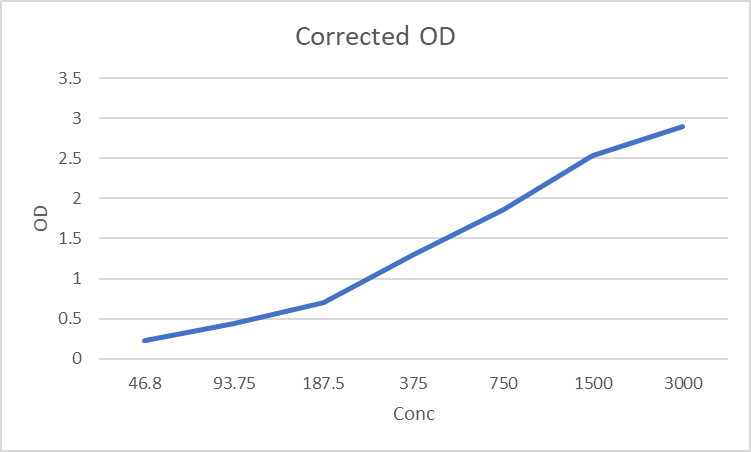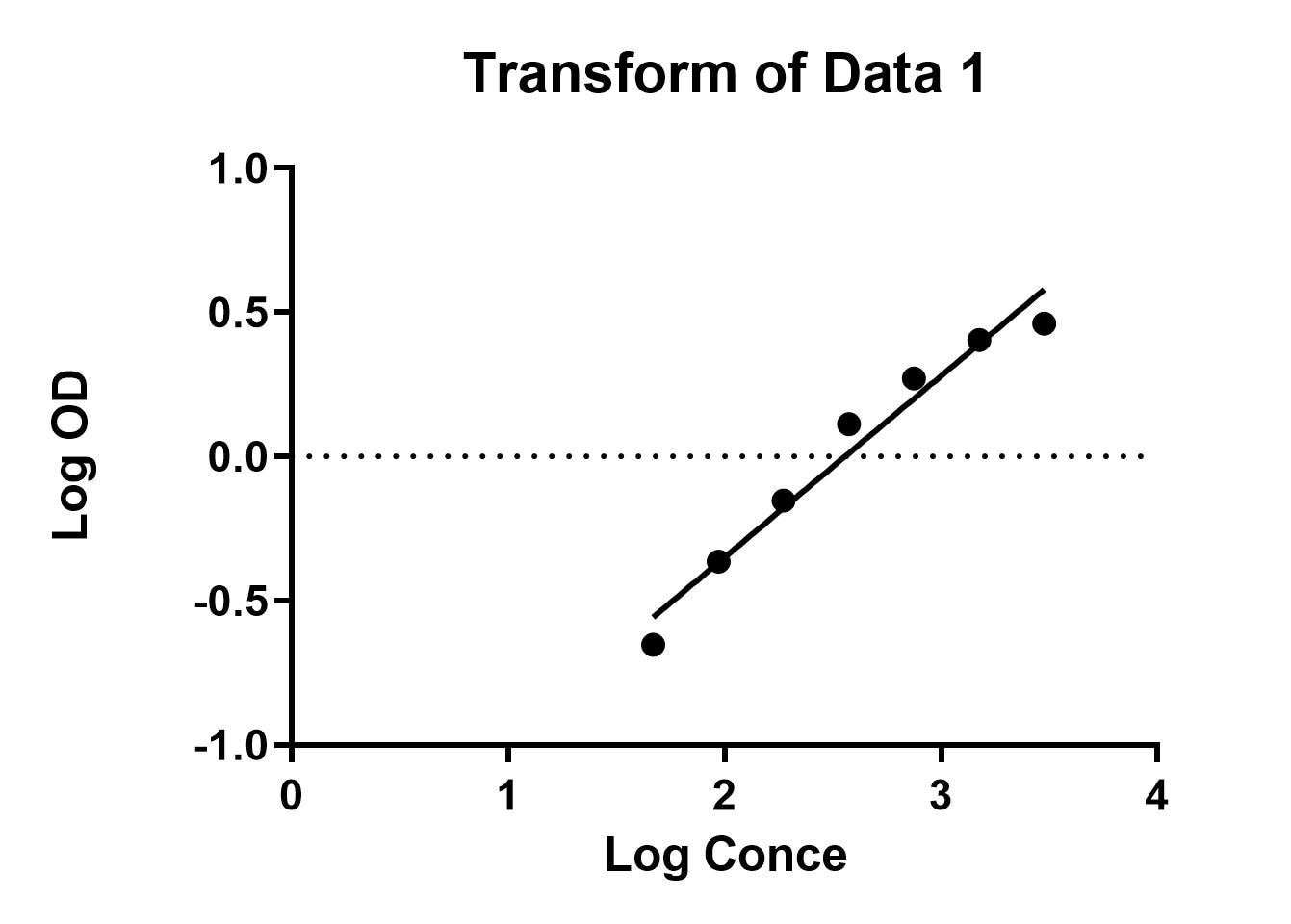Mouse IL-17A/F Heterodimer DuoSet ELISA Summary
* Provided that the recommended microplates, buffers, diluents, substrates and solutions are used, and the assay is run as summarized in the Assay Procedure provided.
This DuoSet ELISA Development kit contains the basic components required for the development of sandwich ELISAs to measure natural and recombinant mouse IL-17A/F Heterodimer. The suggested diluent is suitable for the analysis of most cell culture supernate samples. Diluents for complex matrices, such as serum and plasma, should be evaluated prior to use in this DuoSet.
Product Features
- Optimized capture and detection antibody pairings with recommended concentrations save lengthy development time
- Development protocols are provided to guide further assay optimization
- Assay can be customized to your specific needs
- Economical alternative to complete kits
Kit Content
- Capture Antibody
- Detection Antibody
- Recombinant Standard
- Streptavidin conjugated to horseradish-peroxidase (Streptavidin-HRP)
Other Reagents Required
DuoSet Ancillary Reagent Kit 2 (5 plates): (Catalog # DY008) containing 96 well microplates, plate sealers, substrate solution, stop solution, plate coating buffer (PBS), wash buffer, and Reagent Diluent Concentrate 2.
The components listed above may be purchased separately:
PBS: (Catalog # DY006), or 137 mM NaCl, 2.7 mM KCl, 8.1 mM Na2HPO4, 1.5 mM KH2PO4, pH 7.2 - 7.4, 0.2 µm filtered
Wash Buffer: (Catalog # WA126), or 0.05% Tween® 20 in PBS, pH 7.2-7.4
Reagent Diluent: (Catalog # DY995), or 1% BSA in PBS, pH 7.2-7.4, 0.2 µm filtered
Substrate Solution: 1:1 mixture of Color Reagent A (H2O2) and Color Reagent B (Tetramethylbenzidine) (Catalog # DY999)
Stop Solution: 2 N H2SO4 (Catalog # DY994)
Microplates: R&D Systems (Catalog # DY990)
Plate Sealers: ELISA Plate Sealers (Catalog # DY992)
Scientific Data
Product Datasheets
Preparation and Storage
Background: IL-17A/F Heterodimer
The IL-17 family is comprised of at least six proinflammatory cytokines that share a conserved cysteine-knot structure but diverge at the N-terminus. IL-17 family members are glycoproteins secreted as dimers that induce local cytokine production and recruit granulocytes to sites of inflammation. IL-17 is induced by IL-15 and IL-23, mainly in activated CD4+ T cells distinct from Th1 or Th2 cells. IL-17F is the most homologous to IL-17, but is induced only by IL-23 in activated monocytes. IL-17B binds the IL-17B receptor, but not the IL-17 receptor; it is most homologous with IL-17D, which is expressed by resting CD4+ T cells and CD19+ B cells. IL-17E is mainly produced by Th2 cells and recruits eosinophils to lung tissue. IL-17C has a very restricted expression pattern but has been detected in adult prostate and fetal kidney libraries.
Assay Procedure
GENERAL ELISA PROTOCOL
Plate Preparation
- Dilute the Capture Antibody to the working concentration in PBS without carrier protein. Immediately coat a 96-well microplate with 100 μL per well of the diluted Capture Antibody. Seal the plate and incubate overnight at room temperature.
- Aspirate each well and wash with Wash Buffer, repeating the process two times for a total of three washes. Wash by filling each well with Wash Buffer (400 μL) using a squirt bottle, manifold dispenser, or autowasher. Complete removal of liquid at each step is essential for good performance. After the last wash, remove any remaining Wash Buffer by aspirating or by inverting the plate and blotting it against clean paper towels.
- Block plates by adding 300 μL Reagent Diluent to each well. Incubate at room temperature for a minimum of 1 hour.
- Repeat the aspiration/wash as in step 2. The plates are now ready for sample addition.
Assay Procedure
- Add 100 μL of sample or standards in Reagent Diluent, or an appropriate diluent, per well. Cover with an adhesive strip and incubate 2 hours at room temperature.
- Repeat the aspiration/wash as in step 2 of Plate Preparation.
- Add 100 μL of the Detection Antibody, diluted in Reagent Diluent, to each well. Cover with a new adhesive strip and incubate 2 hours at room temperature.
- Repeat the aspiration/wash as in step 2 of Plate Preparation.
- Add 100 μL of the working dilution of Streptavidin-HRP to each well. Cover the plate and incubate for 20 minutes at room temperature. Avoid placing the plate in direct light.
- Repeat the aspiration/wash as in step 2.
- Add 100 μL of Substrate Solution to each well. Incubate for 20 minutes at room temperature. Avoid placing the plate in direct light.
- Add 50 μL of Stop Solution to each well. Gently tap the plate to ensure thorough mixing.
- Determine the optical density of each well immediately, using a microplate reader set to 450 nm. If wavelength correction is available, set to 540 nm or 570 nm. If wavelength correction is not available, subtract readings at 540 nm or 570 nm from the readings at 450 nm. This subtraction will correct for optical imperfections in the plate. Readings made directly at 450 nm without correction may be higher and less accurate.
Citations for Mouse IL-17A/F Heterodimer DuoSet ELISA
R&D Systems personnel manually curate a database that contains references using R&D Systems products. The data collected includes not only links to publications in PubMed, but also provides information about sample types, species, and experimental conditions.
10
Citations: Showing 1 - 10
Filter your results:
Filter by:
-
Targeting anemia-induced CD71+ reticulocytes protects mice from Plasmodium infection
Authors: Zeydabadinejad, S;Kim, JSA;Zheng, A;Kandalgaonkar, MR;Ababio, PB;Vijay-Kumar, M;Yeoh, BS;Saha, P;
Infection and Immunity
Species: Mouse
Sample Types: Serum
-
Adipose-Derived Stem Cell Exosomes Inhibit Hypertrophic Scaring Formation by Regulating Th17/Treg Cell Balance
Authors: H Wang, Y Li, Z Yue, Y Liu, Q Chen, D Hu, J Han
BioMed Research International, 2022-10-12;2022(0):9899135.
Species: Mouse
Sample Types: Tissue Homogenates
-
ADP-ribosylating adjuvant reveals plasticity in cDC1 cells that drive mucosal Th17 cell development and protection against influenza virus infection
Authors: M Arabpour, C Lebrero-Fe, K Schön, A Strömberg, V Börjesson, K Lahl, M Ballegeer, X Saelens, D Angeletti, W Agace, N Lycke
Mucosal Immunology, 2022-04-13;0(0):.
Species: Mouse
Sample Types: Cell culture supernate
-
TREM2 is a receptor for non-glycosylated mycolic acids of mycobacteria that limits anti-mycobacterial macrophage activation
Authors: E Iizasa, Y Chuma, T Uematsu, M Kubota, H Kawaguchi, M Umemura, K Toyonaga, H Kiyohara, I Yano, M Colonna, M Sugita, G Matsuzaki, S Yamasaki, H Yoshida, H Hara
Nature Communications, 2021-04-16;12(1):2299.
Species: Mouse
Sample Types: Cell Culture Supernates
-
Inhibition of Rho-Kinase Downregulates Th17 Cells and Ameliorates Hepatic Fibrosis by Schistosoma japonicum Infection
Authors: W Zhou, Y Yang, C Mei, P Dong, S Mu, H Wu, Y Zhou, Y Zheng, F Guo, JQ Yang
Cells, 2019-10-16;8(10):.
Species: Mouse
Sample Types: Cell Culture Supernates
-
PAD4-dependent NETs generation are indispensable for intestinal clearance of Citrobacter rodentium
Authors: P Saha, BS Yeoh, X Xiao, RM Golonka, V Singh, Y Wang, M Vijay-Kuma
Mucosal Immunol, 2019-02-01;0(0):.
Species: Mouse
Sample Types: Tissue Homogenates
-
ER? in CD4+ T Cells Is Crucial for Ligand-Mediated Suppression of Central Nervous System Autoimmunity
J Immunol, 2016-05-13;0(0):.
Species: Mouse
Sample Types: Cell Culture Supernates
-
Role of the aryl hydrocarbon receptor in the immune response profile and development of pathology during Plasmodium berghei Anka infection.
Authors: Brant F, Miranda A, Esper L, Rodrigues D, Kangussu L, Bonaventura D, Soriani F, Pinho V, Souza D, Rachid M, Weiss L, Tanowitz H, Teixeira M, Teixeira A, Machado F
Infect Immun, 2014-05-12;82(8):3127-40.
Species: Mouse
Sample Types: Tissue Homogenates
-
Bifidobacterium longum alleviates dextran sulfate sodium-induced colitis by suppressing IL-17A response: involvement of intestinal epithelial costimulatory molecules.
Authors: Miyauchi, Eiji, Ogita, Tasuku, Miyamoto, Junki, Kawamoto, Seiji, Morita, Hidetosh, Ohno, Hiroshi, Suzuki, Takuya, Tanabe, Soichi
PLoS ONE, 2013-11-08;8(11):e79735.
Species: Mouse
Sample Types: Cell Culture Supernates
-
LXR-mediated inhibition of CD4+ T helper cells.
Authors: Solt L, Kamenecka T, Burris T
PLoS ONE, 2012-09-28;7(9):e46615.
Species: Mouse
Sample Types: Cell Culture Supernates
FAQs
No product specific FAQs exist for this product, however you may
View all ELISA FAQsReviews for Mouse IL-17A/F Heterodimer DuoSet ELISA
Average Rating: 4.5 (Based on 2 Reviews)
Have you used Mouse IL-17A/F Heterodimer DuoSet ELISA?
Submit a review and receive an Amazon gift card.
$25/€18/£15/$25CAN/¥75 Yuan/¥2500 Yen for a review with an image
$10/€7/£6/$10 CAD/¥70 Yuan/¥1110 Yen for a review without an image
Filter by:







